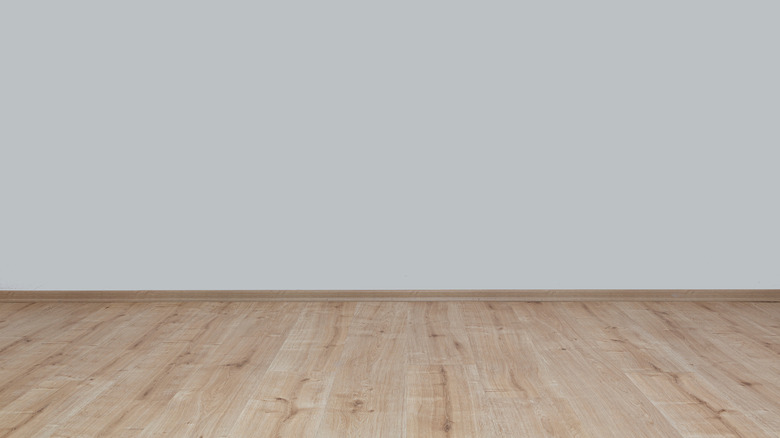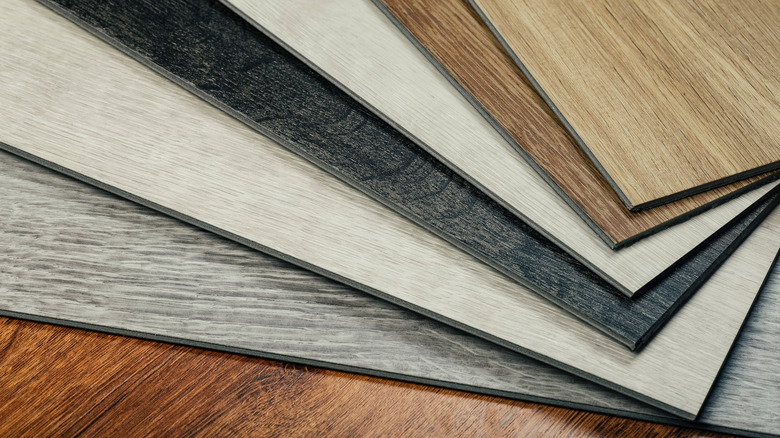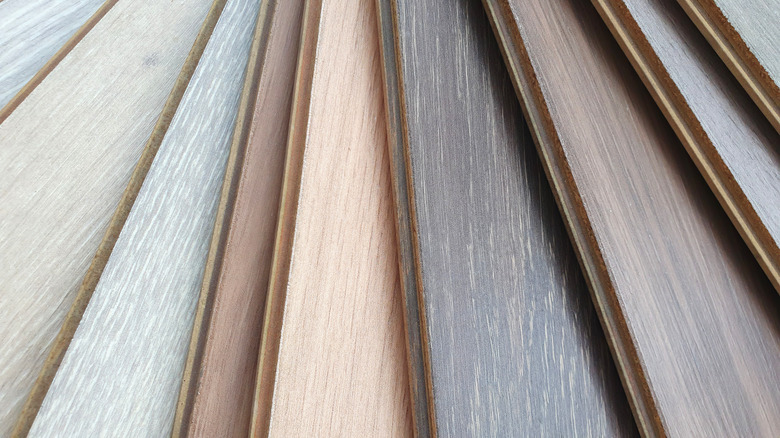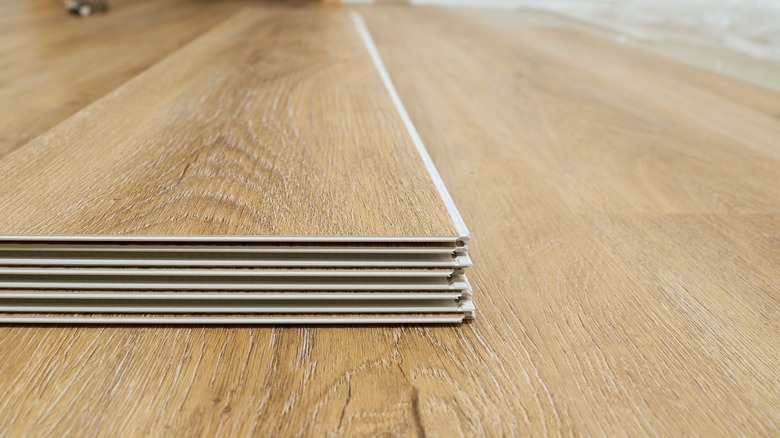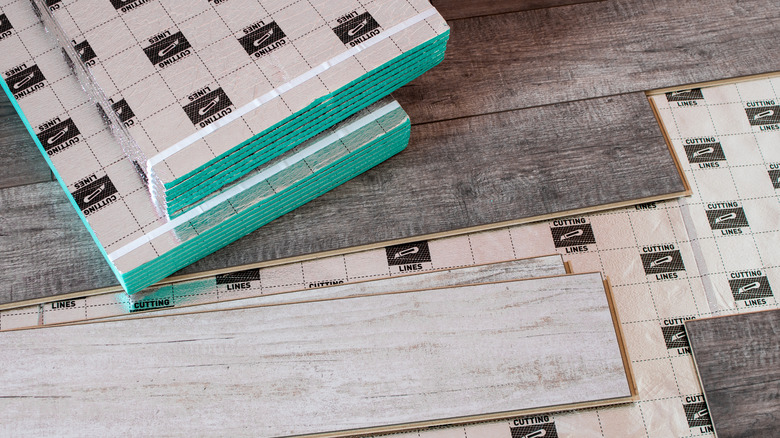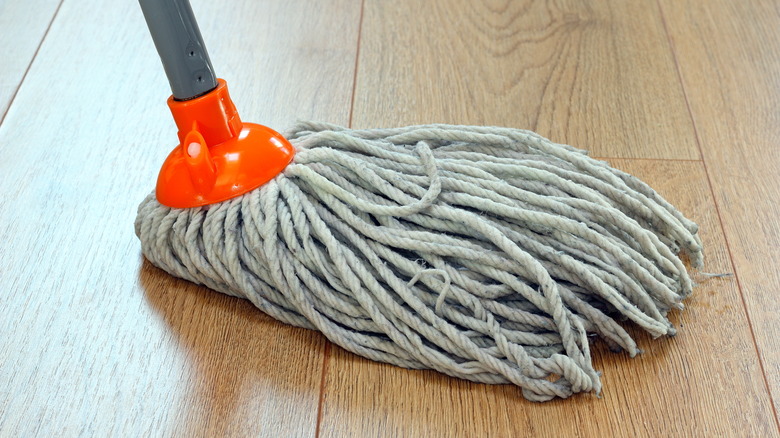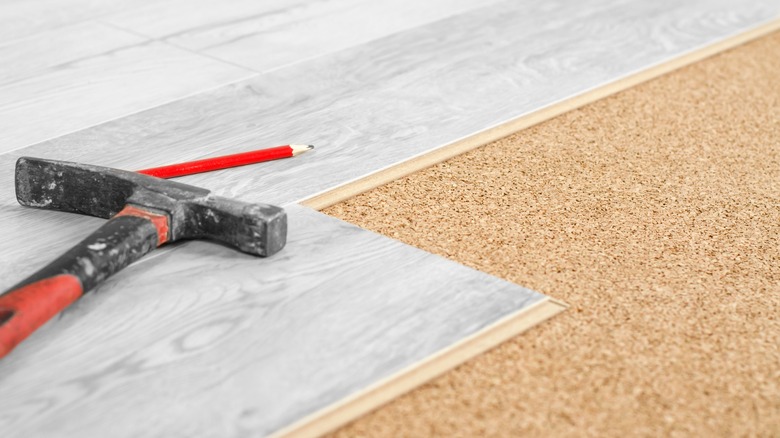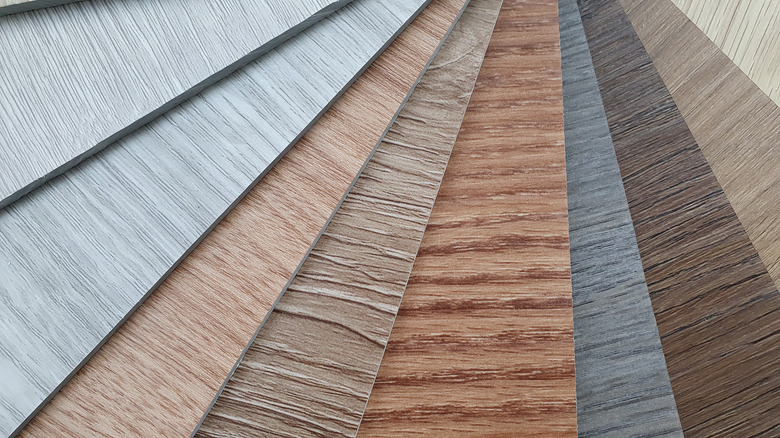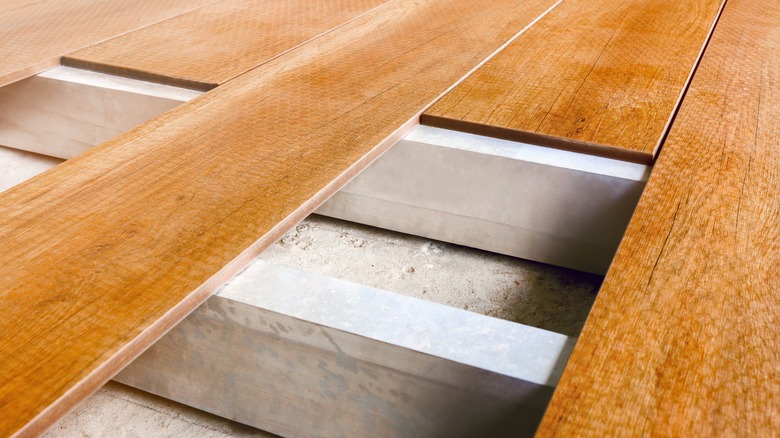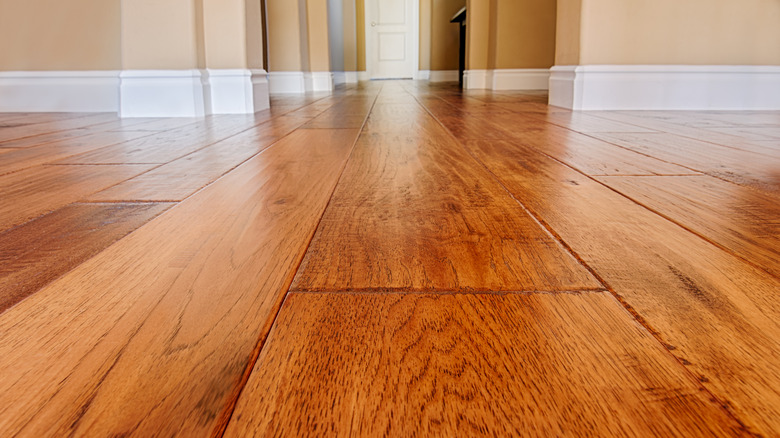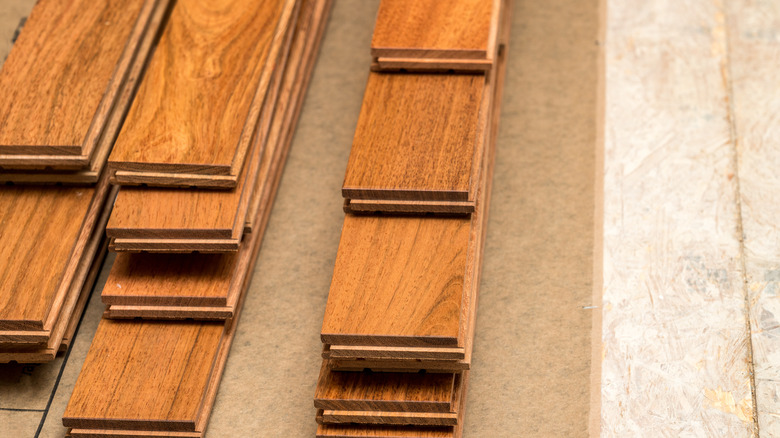Solid Wood Vs. Engineered Wood Flooring: What's The Difference?
Debating on which flooring to include throughout your home can seem like an overwhelming decision. As the options for flooring are near endless, there is a material in particular that has stood the test of time. Wood planks have been a material for groundwork in homes since the Middle Ages. The material expanded into the 1600s French Baroque era and is still reigning supreme in modern-day dwellings. Over the years, wood flooring has found its footing in homes but advances in technology have led to a plethora of floorboard options that make choosing between solid wood and engineered wood the new norm. Although real and engineered panels may look the same, they actually have their differences in cost, and how they are made, installed, and cared for.
Choosing the right flooring is not only a considerable investment but is one that can affect a home's acoustics, visual aesthetics, and resale value. The floor plays a major role in home design. "The right flooring brings everything in the room together," Rich Erath, chief executive merchant at Floor & Decor, told The Boston Globe. "It really completes your project." So which one do you choose? Don't worry, you don't have to figure out flooring all by yourself. We're here, breaking down two of the most popular flooring types: Solid wood and engineered wood flooring. Continue reading so you can confidently reach a decision on which type of wood flooring is suitable for your home and your lifestyle.
How the composition differs
When it comes to wood flooring it would be difficult for you to tell the difference between what's real and what isn't just by walking across the floor or even staring at it. Over time, manufactured flooring has improved drastically, making the flooring appear very similar to its more costly alternatives. As such, telling the difference between solid wood and engineered wood flooring is about more than just what you see with the plain eye and at the surface. In fact, you have to dig a little deeper in order to determine what lies beneath your feet. Just how do you tell the difference between each wood plank style? By how it's made!
According to Build Direct, the structural composition of each flooring type differs even if they both offer the same timeless appearance on the surface. What's inside each plank is what matters the most. The formation of solid and engineered wood flooring is vital to how the product will manage in environmental factors like high humidity areas and instances of moisture. It's in the composition where the differences can actually be seen. Specifically, engineered flooring is composed of multiple layers of high-density (HDF) or medium density (MDF) fiberboard before it's sealed with a veneer top layer and waterproofed. Conversely, hardwood flooring is crafted from a single piece of wood and cut into planks using a variety of methods to create tongues and grooves in hardwood and softwood varieties. It's important to note that solid wood or engineered wood will go through a distressing process once all the stages of assembly are completed. The type of flooring you select for your home should be made to fit your style – inside and out.
How do they look?
At first glance, solid wood and engineered wood flooring appear almost identical. The similarity in texture, color, and tone presents a similar character profile. The availability of a range of color styles and the likeness combined make it really hard for a person to distinguish between actual and imitation wood grain. The reason for this uniform appearance between the planks is that engineered wood flooring is actually topped with a hardwood finish top layer. (via Build Direct). However, upon closer inspection of the floorboards, you may notice they are actually different. You just have to take a closer look and maybe grab a tape measure.
Alternatively, you can always measure the planks as each style of wood flooring differs in dimensions. Standard solid wood floor planks typically measure 2 ¼ to 3 inches wide as per Classic Wood Floors and are available prefinished or unfinished. Whereas engineered wood flooring is available almost always pre-finished and is typically wider with plank sizes ranging from 3 to 7 inches wide (via Hosking Hardwood). When it comes to engineered wood flooring, what you see is what you get. Since engineered wood panels are pre-finished, there are no opportunities to sand down, stain, and refinish the grain on the planks. Unlike floors made of oak, pine, maple, or cedar wood which are able to be altered, recolored, and retouched. The differences are hardly indistinguishable from the surface, leaving selection a matter of personal discretion.
How much will it cost?
When choosing which flooring to have laid out throughout your home, it sometimes comes down to dollars and cents. How much will it cost? This answer is such an important part of any home project and one we don't want you surprised by when shopping around for flooring for your home. Ultimately when it comes to solid hardwood or engineered wood flooring, it's important to note that final costs are always based on the square footage of the area, labor, material, and miscellaneous items. We did however accumulate a basic breakdown of average costs per material type to help make shopping for flooring for your humble abode that much easier for you.
According to Home Advisor, the typical homeowner will spend between $3 and $25 per square foot for engineered wood flooring. Whereas most jobs for hardwood flooring at home can run your wallet anywhere between $6 to $12 per square foot for average jobs or as high as $25 for some others as per Home Advisor. When it comes to choosing solid wood floors one of the biggest cost impacts will be the type of wood as the price will fluctuate drastically from the more common (pine) to the stunningly, outlandish (Brazilian walnut) wood styles. While you can certainly measure the space yourself and determine pricing on your own, for alternative cost estimates you can always consult professionals, especially for those rooms that aren't exactly in the shape of a perfect square.
Not all floors sound the same
When it comes to laying down any type of flooring, real or synthetic, one of the most important factors to consider (outside of how it looks of course) is the underlayment process. You may stop and ask yourself, the what? We're referring to an installation technique that, although unseen from the surface, does a lot of work underneath to support the floor and the room's acoustics. If you have ever walked over a creaky wooden floor or across one in heavy shoes then you have an idea of just where we are going with this. Just which type of underlay to choose depends on personal preference because when it comes to comfort and noise these are two categories where solid wood and engineered wood flooring may actually coincide.
According to Rubber Flooring, Inc. most underlayments are made out of cork, foam, rubber cork, felt, or rubber. For either solid wood or engineered wood flooring, it is recommended to use a cork underlay material. This layer has "less give" as it will flex under the pressure of feet and moving furniture. Furthermore, this specific material helps to absorb noises caused by footsteps, wear and tear, or dropped items. Although preferred, felt and foam are favorable alternatives as well. They have similar noise-reducing capabilities. Ultimately the installation process of the floorboards will determine future pops, cracks, and squeaks. Overall, the best way to keep your floors quiet is by choosing an underlayment that improves sound deadening, locks out moisture, and offers additional support. It's a layer that is crucial to include when considering either wood flooring style for your home.
Proper cleaning and upkeep
Knowing how to clean hardwood floors or engineered wood floors is a factor not to be overlooked, especially if you're the one doing the cleaning. Ideally, you want the floors to last for years regardless of which material you go with for your home's floors. A large part of making sure that happens, is proper cleaning and upkeep. In comparing both wood flooring materials we found each one to be relatively simple and reliant mostly on the commitment of the dweller. Hint: that's you.
When it comes to solid wood and engineered floor planks, the cleaning and upkeep alter slightly – one of them requires a bit more TLC. When it comes to engineered flooring some varieties may be able to tolerate high heat but it's recommended to use a mixture of white vinegar and warm water solution to keep the floor squeaky clean. (via The Home Depot). If you have hardwood flooring such as oak, maple, or cherry, these should not be maintained with steam or high temperatures. The extreme heat may warp the actual wood according to Consumer Reports resulting in possible issues and replacement in the future. To maintain the natural beauty of a solid wood floor, you should sweep it regularly in combination with using a homemade vinegar solution (just like engineered flooring) to wipe down the surface. You want to try to avoid solutions that may contain harsh chemicals which may be damaging to the organic material. Proper care and maintenance will allow you to enjoy the appearance of your floor selection for a long time.
Determine the durability
A floor that holds up well to dents and dings is definitely something you should be considering when looking to install solid wood or engineered wood flooring throughout your home. This is especially true if you have little feet and paws running around. Considering the investment you are making, you want a floor that will hold up well to the daily wear and tear and everyday life things. For wood flooring, it's a matter of determining durability. That's where we come in! To help you determine which type of wood flooring would be best for your family, your home, and your lifestyle.
When it comes to solid wood flooring, it's a timeless aesthetic for any room in any house with any style preference. "Wood is the most sustainable floor covering option out there. It's the only one that's naturally renewable," Brett Miller, vice president of technical standards, training, and certification at National Wood Flooring Association told Architectural Digest. " A solid wood floor can last hundreds and hundreds of years. Most other floor coverings are designed to be disposable." When it comes to solid wood flooring it's a matter of hardness. Each wood type from black cherry (softest) to Brazilian cherry (hardest) has a hardness level that is ranked on the Janka Ratings scale. Any type of wood that ranks as a 950 hardness rating or higher is standard for most home flooring projects. (via American Flooring). The higher the rating the more durable the wood. As for engineered flooring, it does not follow the scale due to its construction process. The process isn't a hindrance though as its layered construction and bonded technique may make it a stronger finish for your floor. Other factors such as the type of finish and maintenance will also contribute to the durability and longevity of each style in your household.
Pick a color and a size
When it comes to choosing the type of flooring for your home, it's not what's underneath that usually determines which style or color of floorboard you plan to decorate with across the house. What will determine if the floor pieces will even make it through the doorway is how the flooring actually appears on the surface; during the daytime and nighttime. What color, tone, temperature, and size plank fits your dwelling best? The color varieties are endless for either type of flooring. The planks can range from cool to warm, dark to light, or fall somewhere in the middle. Solid wood and engineered wood flooring offer a diverse assortment of color options that have gray, amber, brown, or tan tones.
Besides picking the perfect color flooring, there is also the matter of choosing the correct sizing that also needs to be taken into account. While you most certainly can have any size plank laid out across the ground we put together the most traditionally used measurements just for you. According to Real Wood Floors solid hardwood plank sizes range from 6 to 10 inches or more in length and vary in width from standard, wide, or narrow. One of the most common dimensions measures about four or five inches in width. On the other hand, engineered planks can vary per manufacturer but most typically measure about 6 to 8 inches in width and range from 36 to 48 inches in length as per MSI Surfaces. Wood flooring (hardwood or engineered) in the perfect shade that complements the existing furniture and wall color is a great way to upgrade your space.
How they are installed
When deciding which flooring to choose for your home the decision may come down to the installation process. Basically, the way in which the floor will get attached to the ground. The process for solid wood flooring drastically differs compared to engineered wood flooring. We know, we know, color is important, but not all flooring is meant for all spaces regardless of how it looks. If you find yourself wondering what method of installation is best for your dwelling, we are sharing the notable differences between solid wood and engineered wood flooring installation techniques.
For instance, when considering a hardwood style floor there is a need for a secondary floor. "Typically solid hardwood flooring is nailed or stapled to a wood subfloor," Tony Pastrana, installation system developer at Armstrong Flooring told Architectural Digest. This process can take anywhere from 1-5 days when completed by a professional (via The Flooring Girl). Conversely, engineered wood flooring installation doesn't require the use of nails at all. "Engineered hardwood can be mechanically fastened, glued, or installed as a "floating floor", depending on the product selected," Pastrana continued. Did you catch the difference? An engineered floor can float, without being anchored to a subfloor. This is not the case for a hardwood floor install. Another notable contrast is that engineered style flooring can be placed on any level of the home. It's a durable product in bathrooms, laundry rooms, living areas, and bedrooms whereas solid wood flooring cannot be installed in below-grade rooms (via These Floors). Knowing how the floor will be installed in your home may help you choose which one to select for your next flooring project.
When to choose one over the other
When it comes to selecting a solid wood or engineered wood flooring for the home, it could be hard to tell which is which just by the naked eye. The visual comparison between the planks is eerily similar. However, knowing which material is real or synthetic could make a difference in the return on investment (ROI) of the flooring you selected for your home. If the flooring looks almost exactly the same, how do you know which one will get you more for your money down the line? Well, that depends. Not so much on what you prefer, but what others do.
According to USA Today, using data from the National Association of Realtors, they estimate about 54% of home buyers willingly pay more money for real hardwood flooring in a home. Re-read it again (more money). If that many people are willing to pay more dollars and cents for a home based on the type of flooring then a heavy consideration of the ROI is definitely on the table when choosing between each wood style flooring. Making the final decision comes down to personal preference as you are the one who is living with the flooring at the present moment but if there was ever a time to choose to better your future, this may be it. This decision alone could be a significant indicator of the future resale value of your home.
Personal preferences are always recommended
What type of flooring is best for your house? The answer greatly depends on how you plan to use the dwelling. Not every person will agree that the flooring under their furniture and toes is best for their lifestyle. "When choosing a floor, always make sure to consider the space and its function," Sarah Escott, designer manager at Amtico, told Ideal Home. Who is living there? Will you own pets? Will your children roll toys through the kitchen? How you and yours plan to live in the space will tell you whether or not the floor can last underneath your feet! We recommend choosing how you live before choosing your flooring.
Spills happen, feet stomp, messes are memories, and floors need to be there for it all. Beautiful floors can make your home more inviting. So, choose wisely! Between longevity, durability, final costs, installation, and color, your mind is racing to choose which flooring will be "the one." In the end, it all comes down to personal preference and what's best for your budget. Whether you invest in hardwood flooring or prefer the ease and similar appearance of engineered wood flooring, choose the flooring that supports you and your house. If you were wondering what the differences were between engineered wood and solid wood flooring we hope you found some of what you were looking for.
